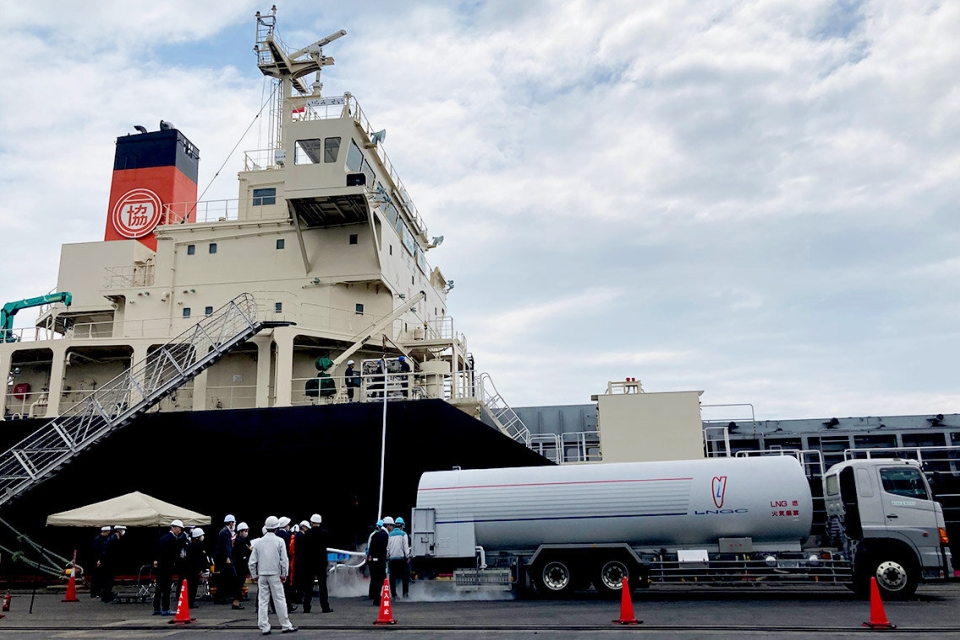A group of seven companies has completed a successful trial using liquefied bio-methane (LBM) derived from cattle manure as marine fuel on the domestic LNG-fuelled vessel Ise Mirai in Ise Bay. This marks Japan’s first use of carbon-neutral LBM derived from biomass.
Teaming up on the project were Mitsui O.S.K. Lines (MOL), Air Water Inc., Techno Chubu Company, Kyoudou Kaiun Co., MOL Coastal Shipping, Cenergy Co., and IHI Power Systems Co.
The trial was conducted based on a memorandum of understanding (MoU) signed between MOL and Air Water in February 2023, with the cooperation of other parties involved.

Also read: MOL takes delivery of first cargo vessel with Wind Challenger hard sail
LBM can use existing LNG supply chain
In the trial, Air Water supplied LBM produced from cattle manure in the Tokachi region of Hokkaido as part of a technology development and demonstration project adopted by Japan’s Ministry of the Environment. LBM has the benefit that it can be transported through the existing domestic LNG supply chain. In addition, truck-to-ship bunkering can be completed using existing LNG tank trucks and LBM can be used by the existing vessel (Ise Mirai) as marine fuel.
LBM is made with bio-methane generated from dairy-owned biogas plants, liquefied at about -160°C, separating and refining its main component, methane. Methane can be compressed to 1/600th of its volume when liquefied, enabling it to be transported on a large scale. It is also a carbon-neutral domestic energy source because it is made from cattle manure.

LNG fuel is expected to reduce carbon dioxide (CO2) emissions by about 25 per cent compared to conventional fuel oil, but further reduction of CO2 emissions can be expected through the partial use of LBM, a carbon-neutral energy source. In addition, because the main component of both LBM and LNG is methane, the existing LNG supply chains can be used.
Also read: Approval in principle for MOL’s Large Liquefied CO2 carrier design
‘Bio-LNG can reduce shipping’s carbon footprint’
The use of LNG is not without disadvantages, in particular concerning methane slip. However, Voirrey Blount, Admiralty Manager at international law firm Reed Smith, does see the benefits of using cow dung to create bio-LNG.
‘LNG has long been touted as an alternative fuel, and it does reduce CO2 emissions when compared to traditional heavy fuel oils,’ comments Blount. ‘However, a big issue with the use of LNG is methane slip. This is where unburnt methane escapes into the atmosphere through the funnel. Methane is one of the leading contributors to climate change and is responsible for around thirty per cent of the rise in global temperatures since the industrial revolution.’
Blount adds: ‘By utilising waste to create the bio-LNG, rather than natural gas extracted from the earth, the total carbon footprint of the process is likely to be reduced significantly. It also prevents large piles of manure from sitting in storage and producing methane as it decomposes. Plus manure can have a very negative effect on the local environment due to the excess nutrients seeping into rivers and lakes.’
‘Similar technology is already being used for experiments to power tractors, trucks and power for homes. With the infrastructure for LNG already being in place moving to bio-LNG seems like a simple step in the quest to reduce shipping’s carbon footprint,’ concludes Blount.
Pictures by MOL.
Also read: EU funding for Green Ray project to tackle methane slip








